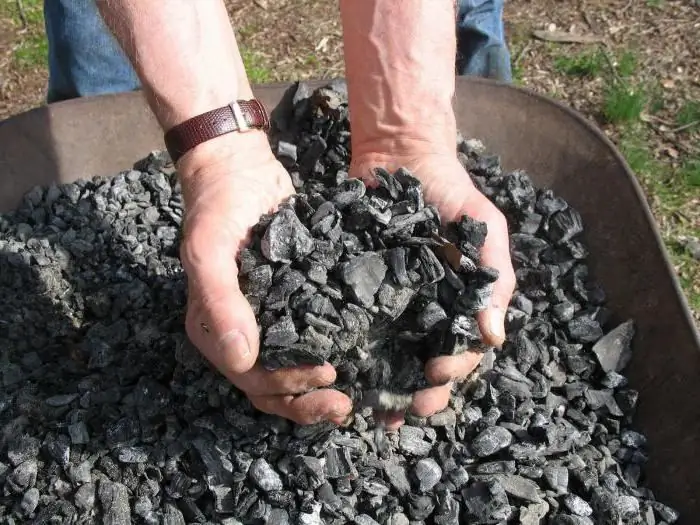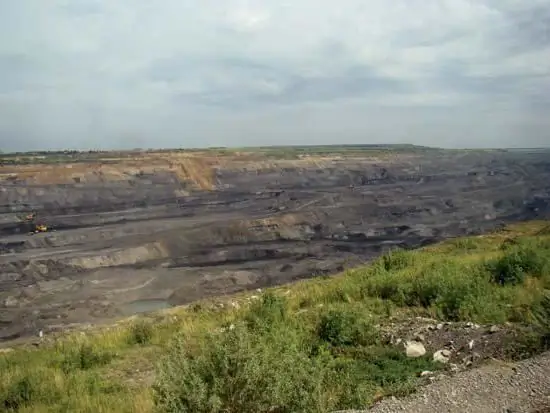2025 Author: Howard Calhoun | [email protected]. Last modified: 2025-01-24 13:10:25
The Moscow Region coal basin, or, as it is also called, Mosbass, is located on the territory of several regions of the country at once. This deposit is considered brown coal.
The beginning of the story
For the first time, natural resources in this area were discovered back in 1772. The extraction of raw materials began to be carried out only in 1786. At that time, the first adit, belonging to the Moscow region coal basin, was opened. It was located on the territory of the Novgorod region near the city of Borovichi. It is worth noting that by the middle of the 19th century, the number of deposits that were discovered on the territory of Mosbass reached 76. However, they were not developed constantly, but only occasionally.

The first systematic mining on the territory of the Moscow region coal basin was organized only in 1855 by Count Bobrinsky. The location of the production was concentrated near the village of Malevka. Currently, this area belongs to the Bogoroditsky district of the Tula region. About 10 thousand tons of coal were mined in this area in 1856.
Mine operation
The history of the development of mines in the area and the general mining industry was not very productive and not constant. The reason for this was that there was a monopoly of foreign capital in this sphere of production. After 6 years, in 1862, coal mining began in the area of the village of Tarkovo, and after some time in other places of Mosbass. However, the mines did not work constantly, but seasonally, for the reason indicated above.

Here it is worth noting that the lack of mechanization, as well as the general disorganization of coal mining in the coal basin near Moscow at that time, led to the fact that the annual production of the entire Tula region was no more than 700 thousand tons per year. This indicator was observed at the beginning of the 20th century. Compared with the output of modern mines, the entire region produced as much raw materials as only one modern mine produces today. However, this figure was equal to the fact that Mosbass in 1913 brought 24% of the total income of the gross output of the entire province.
Getting Started
The Moscow region coal basin in Russia is the oldest coal mining site. And this despite the fact that the full-scale extraction of raw materials in this area began only in 1920. The reason for this was the development of the project, according to which the idea of using local fuel resources was implemented. The second reason was that there was a need to supply coal to the Central region due to the ongoing civil war. Industrial scale development has taken place in areas such asTver, Tula, Kaluga, Smolensk.

Further, it is worth noting that in 1941 the Tula region was considered the most developed region of Mosbass in terms of coal mining. However, active hostilities also unfolded there at that time, due to which many mines were blown up or flooded. But here it is worth adding that due to the occupation of Donbass, immediately after the liberation of this region, work on the extraction of raw materials was resumed.
Post-war
After the end of hostilities, the prospects for the Moscow region coal basin were quite large. 90% of all coal mined on the territory of Mosbass was concentrated in the Tula region. The highest rate of extracted raw materials was recorded in 1957. During this period, 44 million tons of coal were mined.
It is also worth noting that for 20 years, from the 1940s to the 1960s, a technology called coal gasification was actively used in this basin. Each of the deposits of raw materials was capable of producing more than 100 thousand tons per year. The opening of the sections began in 1958 from the Tula region. The first place was designated as "Kimovsky cut". It was followed by three more: "Bogoroditsky", "Gryzlovsky", "Ushakovsky".

Development of Mosbass to the present day
In the 60s, a gradual decline in coal production in the basin was recorded. The problems of the coal basin near Moscow were that the qualityextracted raw materials turned out to be low. At the same time, deliveries of cheaper raw materials - natural gas, as well as fuel oil - begin to the central regions of the country.
The quality of coal from Mosbass - the average ash content of 31%, 3% sulfur, 33% moisture, as well as the calorific value of 11, 4-28, 2 MJ / kg - began to be considered bad. In addition, the cost of extracting this substance was quite high due to the fact that there was too much water cut in the reservoirs. For these reasons, in the 1980s and 1990s, almost all the mines of the Moscow region coal basin were closed. Until 2009, the last mine with the name "Podmoskovnaya" worked. However, this facility was also closed this year. If we take the entire period of work of Mosbass, then it has delivered more than 1.2 billion tons of coal to the country for all time. Currently, this raw material is not mined in the basin.

The main consumers of coal were local industrial enterprises. The largest of them were considered power plants. Even by 2000, the local energy structure was considered the largest consumer of local coal.
Characteristics of the Moscow region coal basin
If we talk about the parameters of the pool, they are quite impressive. The total length of coal-bearing deposits is about 120 thousand km. This is taking into account the fact that only a depth of up to 200 m was taken into account. The width of the arc-shaped production strip is from 80 to 100 km. At the beginning of 2000, the reserves of raw materials in this basin are estimated at 1.5 billion tons.
It is important to note thatlayers of minerals alternate with layers of waste rock. Due to the discontinuous occurrence of seams, often occurring floating waters, the operation of Mosbass is very complicated. Since this object is a site for the extraction of brown coal, and it, in turn, oxidizes quite easily in the mine, an increased content of carbon dioxide is always observed in the air during its extraction. This factor leads to the formation of gas pollution in the workings, which threatens the lives of all workers. Another difficulty in the development of this field was that there is a high water cut in the reservoirs.

Due to all these characteristics, the development of the Moscow region coal basin is practically not discussed.
Main parameters of Mosbass
The occurrence of brown coal seams in this basin is almost horizontal. They are located at a depth of 50 to 150 meters. The thickness of all layers is 2-4 m and more. The average indicator for this parameter is 2.5 m. Brown coal mined in this region is of low quality, since the ash content is in the region from 25 to 40%, sulfur content from 2 to 6%, humidity from 30 to 35%. An important indicator that the extraction of raw materials in Mosbass is not profitable is the average cost of production, which exceeds the average for the entire industry by 38%.

In the early stages of development, this basin was quite active and supplied a significant amount of raw materials. However, already in the postwartime, development and production of coal were greatly reduced. The volume of extracted substance did not exceed 40 million tons per year.
Beginning in 1993, the basin was restructured, during which 24 of the 28 main mines were closed. After that, only three mines functioned, as well as one cut.
Other perspectives
Despite the fact that the extraction of brown coal in the territory of Mosbass is not reasonable, it has deposits of other minerals that are quite possible to be mined.
The group of such fossils includes a thickness of halogen sediments, the thickness of which is from 35 to 50 m. The occurrence of the reservoir is at a depth of 730 to 988 meters. The raw material is rock s alt, which is 93-95% halite. It is important to note here that this raw material is characterized by sustained power and good quality. According to experts, the number of rock s alt deposits in the entire territory of the Moscow region coal basin is in the region of 657 billion tons.
Pool Features
In addition to rock s alt deposits, there are also fossils such as gypsum. This substance is confined to the lagoon-carbonate-gypsum deposits of the Upper Devonian lake strata. The thickness of this stratum is from 8 to 49 meters, but the average is from 15 to 25 meters. The depth of the layers is from 32 to 300 meters. There is a gradual subsidence of these layers towards the central parts of the Moscow syneclise. To date, only one field is being developed - Novomoskovsky. Experts estimate the mineral reserves in this area at 858.7 million tons.
Because ofgeological structure of the Moscow region coal basin, it contains deposits and rocks such as carbonate. This material is characterized by a fairly high quality, good mining performance, high power, low water cut. About 150 deposits of carbonate rocks have been discovered throughout Mosbass. The total number of reserves from all fields in this area exceeds 1 billion m3.
Recommended:
Waste recycling in Russia: features, requirements and interesting facts

Recycling of waste in Russia is in its initial state. The plans of the Ministry of Natural Resources to build waste incineration plants can cause irreparable damage to the environment and public he alth. It is necessary to follow global trends, first of all, to collect garbage, sorting it
Coal: mining in Russia and in the world. Places and methods of coal mining

The coal mining industry is the largest segment of the fuel industry. Every year, the level of coal production increases all over the world, new technologies are mastered, equipment is improved
Brown coal. Coal mining. Brown coal deposit

The article is about brown coal. The features of the rock, the nuances of production, as well as the largest deposits are considered
Ruhr coal basin: description

The article describes the geographical features and minerals of the North Rhine-Westphalia region, in which the Ruhr coal basin is located. a brief summary of the history of the development of the region and the post-industrial phase of development, which replaced the rapid industrial growth, is given
Lena coal basin: geographical location, characteristics of reserves, methods of extraction

This article describes the Lena coal basin. It is one of the largest in the world in terms of the volume of coal deposited in it. But at the moment it is poorly exploited due to its remoteness, but this does not make it less interesting to study

